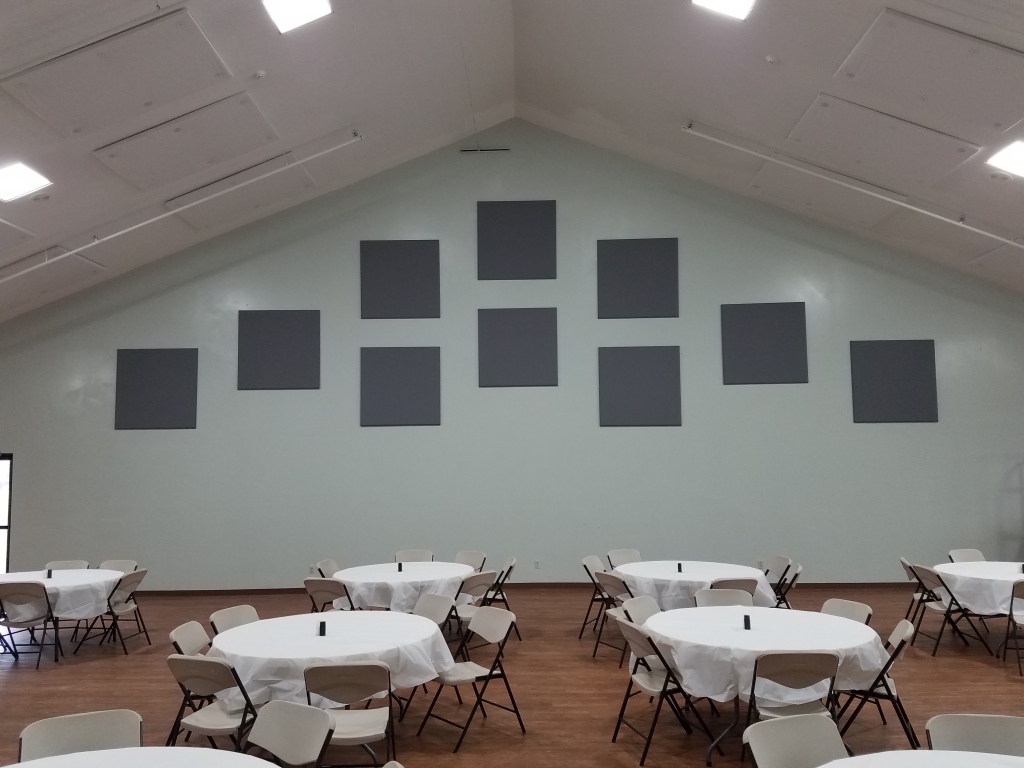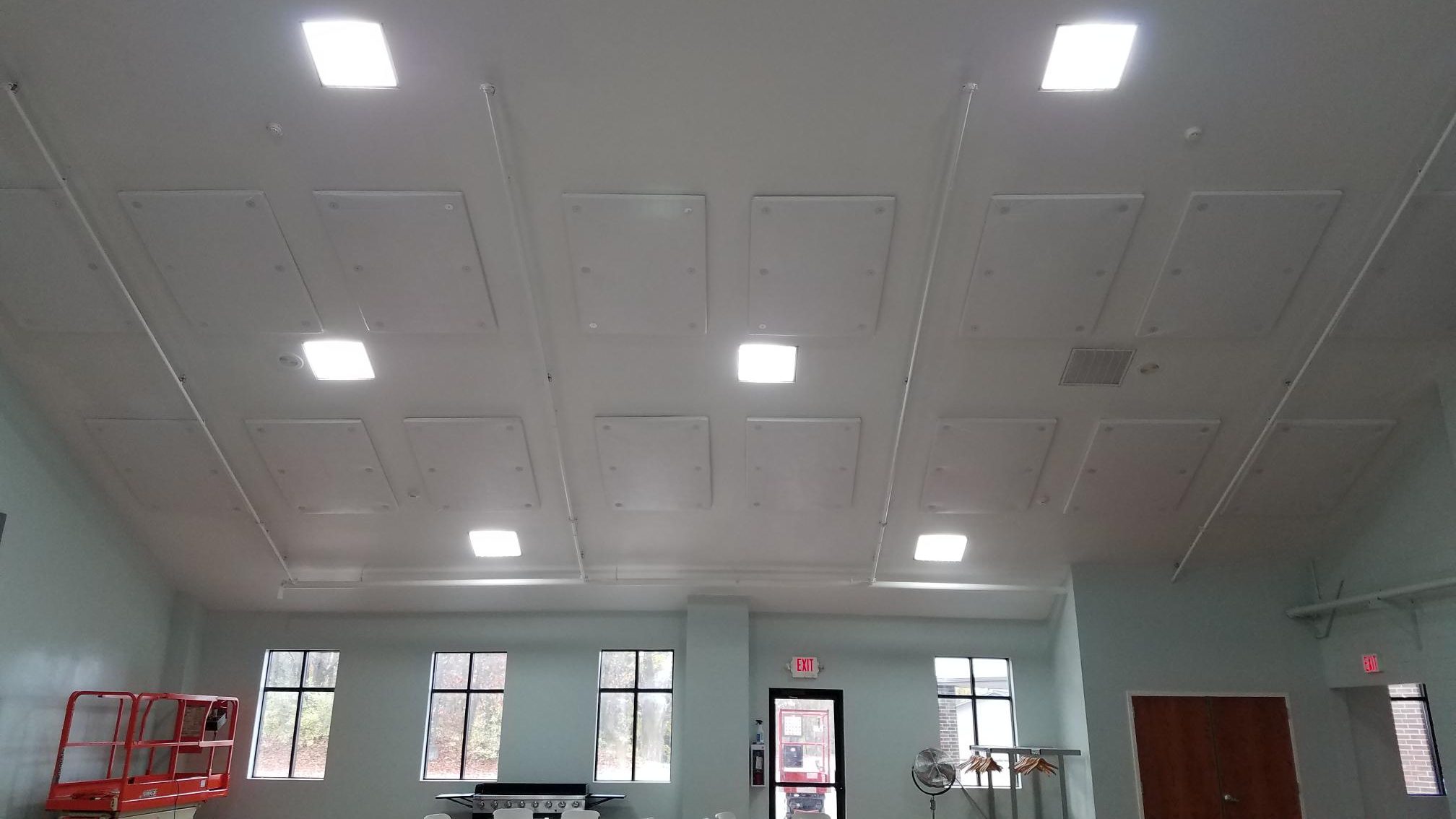Archive for category Worship Facilities
St. Andrew by the Bay – Custom HiPer® Impact Panels to absorb and diffuse sound!
Posted by Acoustics First in Absorption, Diffusion, Product Applications, Worship Facilities on April 10, 2024
St. Andrew by the Bay is a traditional worship facility with a focus on spoken word worship and congregational singing. The large volume and hard surfaces in this space are the physical features most at fault for excessive reverberation, comb filtering and distracting “slap” echoes (discrete sound reflections usually caused by a distant, reflective back-wall).

To correct the slap-back and curb excessive reverb without “over deadening” the space, we recommend distributing approx. 550 SQFT 1” HiPer® Impact absorber/diffuser panels throughout the rear wall areas (see attached layout). HiPer® Impact panels absorb low frequencies and diffuse high-frequencies, yielding a much more even room response. In addition to controlling bass buildup, the high-frequency scattering will help retain some “life” in the room for acoustic and choral performances.
Reverb Prediction – Historically, churches relied on an abundance of hard surfaces to propagate sound to the rear of the nave, so they benefited from very long reverb times (upwards of 4-5s). Modern sound systems allow for a much more focused sound and equitable listening environment , so these extreme reverb tails are no longer necessary and can actually degrade the experience of the congregation. Churches of this size with a sound system and traditional worship services should have a reverb time somewhere in the 1.5-2.25s range. We entered the sanctuary’s dimensions and construction materials into our acoustic calculator and made a prediction of reverb times before and after treatment.

From Lee Hartman & Sons who performed the install “Here are some photos of the finished panels at St. Andrew by the Bay. It turned out great and client is very happy. Many thanks to Cameron for the detailed layout.”

Project: Richmond Friends Retreat Center
Posted by Acoustics First in Absorption, Media Room, Multipurpose Rooms, Product Applications, Products, Worship Facilities on October 26, 2023

Earlier this summer, Richmond Friends Meeting reached out to Acoustics First® for assistance with their new Retreat Center in Amelia, VA. Their multi-purpose community hall was overly live with reverb and echoes, contributing to a poor listening environment. As this space is used for worship, meetings and social events, speech intelligibility is very important and more control was needed to “reign-in” excessive noise.
To correct these issues, Acoustics First® recommended a combination of 1” Hi-Impact Sonora® Wall Panels and 2” Sonora® Ceiling Panels. The acoustic design utilized “staggered” 2’x6’ ceiling panels to maximize coverage, in addition to the custom-shaped wall panels which match the slope of the ceiling.

With approx. 400 SQFT of panels between the wall and ceiling, reverb was reduced by approx. 50%, drastically improving speech intelligibility and general room comfort.


The treatment tamed the acoustics of the room, which improved speech intelligibility by reducing the reverberance… and they were very happy with the result!
Similar, Yet Different: Aeolian® vs. MiniAeolian™
Posted by Acoustics First in Broadcast Facilities, Home Entertainment, Home Theater, Media Room, Multipurpose Rooms, Music Rehearsal Spaces, Music Tracking Room, Product Applications, Products, Recording Facilities, Recording Studio, Studio Control Room, Uncategorized, Vocal Booth, Worship Facilities on September 28, 2023

In this installment of “Similar, Yet Different”, we are going to compare the two current variations of the popular Aeolian® Diffuser – the original 2’x2′ Aeolian and the 1’x1′ MiniAeolian™!
Design
This comparison has some similarities to the very first “Similar, Yet Different” post we made comparing the ArtDiffusor® Model C to the ArtDiffusor® Model F. We are looking at a diffuser that uses identical mathematic functions to create the shape… both the Aeolian® and the MiniAeolian™ are an “Organic Quadratic” constructed from a Bicubic Interpolation of a Quadratic Residue Function. They are both truncated so that they are completely asymmetric, even to the edge. The MiniAeolian™ IS an Aeolian®, only it is scaled differently.
You may recall that the Model F was constructed of 4 scaled down Model C diffusers in a monolithic 2’x2′ tile – This is not the case with the MiniAeolian™. The Original Aeolian® Diffuser is a 2’x2′ footprint that is 5″ tall, and will fit in a standard 2’x2′ ceiling grid. The MiniAeolian™ is a single scaled down unit, and it is a little different – The 1’x1′ footprint stands alone as a single unit, but it is only scaled down in height to 4″.
In this case, form follows function. The MiniAeolian™ was built to fill a specific function as a smaller wall-mount unit, or a direct-mount ceiling unit for smaller spaces. Part of this wall-mount function was to have a version of the Aeolian® that would fit in tight areas or in spaces that didn’t have enough clearance for the 5″ standard Aeolian® (or would require modification to those areas (or diffusers) to allow this extra height). Some people implement configurations that have tighter footprint requirements, and the 1’x1′ footprint of the Mini allow it to be used in these types of layouts.
Performance
So how does this change affect the performance of the unit? Surprisingly, they are quite similar. The Organic curved design, with only a 20% reduction in height, shows only minor differences in performance of their overall frequencies ranges – with both primary ranges starting at about 1500Hz-1600Hz with and average between 150° and 170° of horizontal and vertical dispersion up to between 5Khz and 7Khz. While the primary range is a good indicator, when we look at the actual polar response, we can get a better picture of their full range performance.

A quick glance shows two very similar performing diffusers, except for the low-frequency performance. The larger elements and deeper formfactor of the original Aeolian® are more effective at the 1000Hz range, where the MiniAeolian™ appears to be mostly specular. There are some surprises however. It appears that at the 2000Hz range leans slightly in the favor of using 4 MiniAeolians™ in an array verses the single Aeolian®. There is more surface variation over the same footprint (2’x2′ in the array of 4), and the size of the Mini’s features are a bit more optimal for diffusing the 2Khz wavelength. This swings back slightly into the favor of the single Aeolian® at 4Khz, where the larger elements have a wider throw, and the elements of the Mini have steeper wells. At 8Khz, it tips back to the Mini, and then at 16Khz, they are both neck-and-neck.
The amazing similarity is that the variations are quite subtle through their entire effective ranges, and even quite a bit above those ranges. While there are slight differences in the performance of the diffusers when we compare the directly, these are really very minimal except for the low-frequency edge in performance of the larger original Aeolian®.
Closing
With the similarity of performance in the two diffusers, they can almost be used interchangeably – or even used together in the same environment to implement an aesthetic vision or add more randomness/variety to the diffusion in the space.
There are several occasions where you may require one over the other.
- If you need more 1Khz diffusion, you should add some 2’x2′ Aeolians® – as they perform better in that range.
- If you need to install diffusers that fit in a ceiling grid… you will also want to use the original.
- If you want the Aeolian® but need diffusers that will fit in a space that is less than 2’x2’x5″, you may want to go with the MiniAeolian™.
Currently the MiniAeolian™ is a custom order item only, and is subject to minimum order quantities.
Contact Acoustics First® for more information and pricing.
Sonora® & Sonora® Lite – together in Michigan
Posted by Acoustics First in Absorption, Customer Feedback, Product Applications, Products, Worship Facilities on November 30, 2022

Here are a couple of fresh install photos – courtesy of SLS Productions in Michigan. For this fellowship hall at Kalamazoo Missionary Church, a mix of standard Sonora® Panels and Sonora® Lite PVC encapsulated panels were used. The Steel Grey Sonora® Panels, installed on the wall, are the standard 6-7# density panels that have become ubiquitous in so many churches and schools throughout the country for improving speech clarity and taming harsh reverb times.

For the ceiling of the room, Sonora® Lite Panels were used. Notice how the white PVC covering and clear washer plates help the panels blend aesthetically into the ceiling. These lower density (1.65#) PVC encapsulated panels could be thought of as a ‘direct mount’ cousin of our Cloudscape® baffles and are an excellent budget friendly choice when treating ceilings. The final results turned out great and all were pleased.
Case Study – St. Francis of Assisi Church
Posted by Acoustics First in Absorption, Customer Feedback, Product Applications, Worship Facilities on May 20, 2022

Historically, churches relied on an abundance of hard surfaces to propagate sound to the rear of the sanctuary, so they benefited from very long reverb time (upwards of 5s). However, Modern sound systems allow for a much more focused sound and equitable listening environment, so these extreme reverb tails are no longer necessary and can actually degrade the “modern” worship experience. St. Francis of Assisi Church is a prime example of how incorporating sound absorptive treatment in phases can “transition” a purely-traditional worship space into one that can accommodate a wider range of worship services.
Over the years, St. Francis of Assisi has expanded their music program to include more modern instrumentation. Drums and amplified instruments have been added to liturgical piano and choral worship music. St. Francis of Assisi’s sanctuary has a lofty ceiling, tile floors, hard wall and ceiling surfaces. These factors contribute to a exceedingly reverberant worship environment in which contemporary music is hard to perform and enjoy and speech is difficult to understand.
Back in 2013, the church had an acoustic study performed to detail the acoustic characteristics of the space and identify corrective measures. Using this study and on-site reverb tests, Acoustics First provided a treatment plan that focuses on improving speech intelligibility and music clarity. We settled on a “two-phase” approach, starting with treatment of the rear and side wall areas with 2” Sonora wall panels. A second round of treatment focusing on the ceiling would be added, If needed, to further reduce reverberation down closer to ideal levels.
To help facilitate an informed decision, Acoustics First provided reverb prediction charts that showed the expected improvement from each round of treatment. Aesthetics were a top concern, so 3-D renderings were also provided to help visualize exactly what the recommended treatment would look like. Acoustics can be subjective, so there was a chance that the church might be satisfied with just the wall treatment alone and would not need to proceed with the second phase of treatment. However, after hearing the improvement that the wall panels made the church immediately gave the go-ahead for the ceiling treatment. Safe to say, they were happy with the end results.
From Mike Staffan at Lighthouse sound who took reverb measurements before and after “I am very pleased with the final reverb times and how it turned out. I think our measured approach worked well”
From the Deacon – “This is fantastic, exactly what we were looking to accomplish! – Deacon Chris

You must be logged in to post a comment.